How to Fix Error 0x80070141 (Device is Unreachable)?
Several Windows users have been reaching us with questions after getting the Error 0x80070141: The Device is unreachable when trying to perform certain actions. In most cases, the error code is reported to occur in situations where the user is trying to open, copy or move a JPEG file from a camera storage device to a computer. As it turns out, the issue is not exclusive to a certain Windows version since it’s appearing on Windows 7, Windows 8.1 and Windows 10.

What is causing the 0x80070141 (Device is unreachable) error?
We analyzed this error code by looking into various user reports, consulting the official documentation and trying out the various fixes that are recommended for this problem. As it turns out, this particular error message is known to occur in several different scenarios. Here’s a shortlist of the potential culprits that might be responsible for the error:
- File Explorer glitch – Based on a lot of user reports, it seems like the error code can also appear in instances where File Explorer is glitched and can’t maintain a stable external storage device connection. In this case, you should be able to fix the issue by running the hardware and device troubleshooter.
- Faulty/insufficient USB port – It’s possible that the error code is thrown because one of the two connection ports are not properly inserted or because the USB port that is used is insufficient. If this scenario is applicable, you can fix it by using a different USB port to connect the external storage device with the computer.
- Outdated iTunes version – Another possible cause that could facilitate the error in situations where the user tries to copy files from an iOS device to Windows is an outdated iTunes version. Several affected users have reported that they managed to fix the issue by updating the iTunes version to the latest.
- The hotfix is not installed – Since the issue can also be caused by a Windows 10 bug, Microsoft has released a hotfix for this issue. To take advantage of it, all you need to do is install all pending updates and bring your OS to build up to date.
- File / Pathname is too large – Another possibility is that the error is being caused by an unusually large file name or path. Since Windows is unable to process files with a name or path exceeding 256 characters, you need to shorten the path to fix the issue.
- The transfer protocol is not MTP – If you’re trying to copy files from an Android device, chances are you’re seeing the error because the transfer protocol is not set to MTP. In this case, you should be able to resolve the issue by changing your Android USB connection preferences so that it connects as a Media device.
If you’re currently struggling to resolve the same error message, this article will provide you with several different troubleshooting guides. Down below, you’ll find a collection of potential fixes that other users in a similar situation have successfully used to resolve the Error 0x80070141. Each of the methods is confirmed to be effective by at least one affected user.
For the best results, we advise you to follow the methods below in the same order that we arranged them in. We ordered them by efficiency and difficulty. Eventually, you should stumble upon a fix that will successfully resolve the problem regardless of the culprit that’s causing it.
Method 1: Running the Hardware and Device troubleshooter
As it turns out, this particular issue can occur due to a File Explorer glitch that renders your OS unable to establish a stable connection with the external storage device. Before you explore other repair strategies, you should start your troubleshooting guide by ensuring that Windows is unable to resolve the issue automatically.
Several affected users managed to resolve the issue simply by running the Hardware and Device troubleshooter. This utility will investigate your device for any issues that are already covered by repair strategies and recommend a viable fix if a problem is found.
Here’s a quick guide on running the Hardware and Device troubleshooter:
- Open up a Run dialog box by pressing Windows key + R. Once you’re inside the Run window, type “ms-settings:troubleshoot” and hit Enter to open up the Troubleshooting tab of the Settings tab.

Accessing the Troubleshooting tab - After you arrive in the Troubleshooting tab, scroll down to the Find and Fix other problems section and click on Hardware and Devices. Next, click on Run the troubleshooter from the newly appeared context menu.
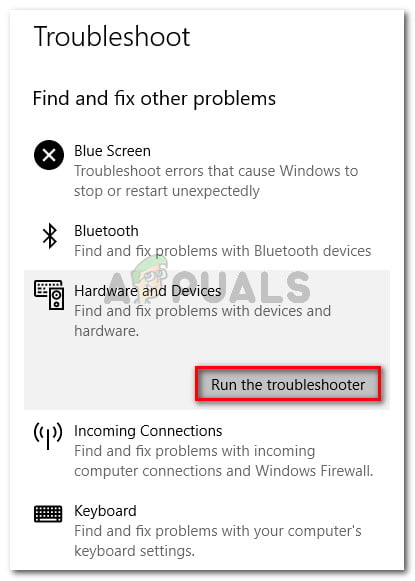
Click on Hardware and Devices and click on Run the troubleshooter - Once the troubleshooter is started, wait patiently until the investigation phase is complete. If a viable repair strategy is found, click on Apply this fix to enforce it.

Apply this fix - After the fix is applied, restart your computer and see if the issue is resolved at the next system startup.
If you’re still seeing the 0x80070141 (Device is unreachable) error when trying to copy media files from an external storage device, move down to the next method below.
Method 2: Reconnect with a different USB port (if applicable)
As some affected users have reported, this particular issue can also occur in situations where the users try to copy files from an external device with an unstable connection. One of the most probable causes for this issue are situations where one of the two connection ports is not properly connected.
It’s also possible that you connected the device to a partially functioning USB port that doesn’t have enough power to support the task at hand.
Some users that we’re also encountering the 0x80070141 error have reported that they managed to fix the problem by disconnecting the device from the USB port and connecting it to a different port.
NOTE: If you’re trying to copy files from an older device (like a traditional camera), try to connect it to a USB 2.0 instead of 3.0, since the issue might also occur because the device doesn’t have the necessary drivers to function on a USB 3.0 connection.
If you’ve reconnected your external device to a different port and you’re still encountering the same error message,
Method 3: Update iTunes to the latest version (if applicable)
If you’re trying to copy something from an Apple device (iTunes, iPad, iPod) to a Windows computer, chances are the issue is happening due to a severely outdated iTunes version. Several affected users have reported that they managed to fix the issue after they updated iTunes to the latest version available.
To update iTunes, open the application on your computer and click the Help button from the ribbon bar at the top, then click on Check for updates.
 Follow the on-screen instructions to complete the update, then restart your computer and see if you can copy the files that were previously failing.
Follow the on-screen instructions to complete the update, then restart your computer and see if you can copy the files that were previously failing.
If you’re still encountering the 0x80070141 error even after updating iTunes or this method didn’t apply to your scenario, move down to the next method below.
Method 4: Install all pending Windows Updates (if applicable)
Although we were not able to pinpoint the exact update, it seems like Microsoft has already released a hotfix for this particular issue. Several users have reported that the 0x80070141 error code was no longer occurring when they tried to copy the image files from an external device, which is further proof that the issue has been already patched.
To take advantage of the hotfix, you’ll need to install every pending update until you bring your Windows build up to date. Here’s a quick guide on installing every pending Windows update:
- Press Windows key + R to open up a Run dialog box. Then, type “ms-settings:windowsupdate” and press Enter to open up the Windows Update tab of the Settings app.

Opening the Windows Update screen - Once you’re inside the WIndows update screen, click on Check for updates and wait for the scan to complete.
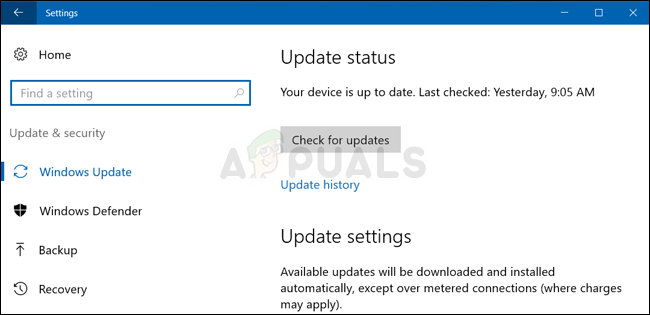
Check for updates in Windows 10 - Once the initial scan is complete, follow the on-screen instructions to install every pending update until your Windows version is up to date.
Note: If you have a lot of updates pending, chances are you will be prompted to restart before all updates are installed. In this case, follow through with the instructions, but make sure to return to this screen at the next startup and install the rest of the updates. - After every update is installed, restart your computer once again and see if you’re able to copy the same file that was previously triggering the 0x80070141 error.
If you still encounter the same error message, move down to the next method below.
Method 5: Shortening the filename (if applicable)
As some users have discovered, the 0x80070141 error can also occur due to some Windows file name restrictions. The reason you’re seeing this error may be that Windows is trying to manage a file with an unusually long path or filename.
If this scenario is applicable, the only viable fix it to rename the file in question so that it stays under the 256 character limit. The easiest way to do this is to use File Explorer to navigate to the file that is failing to be copied over, right-click on it and choose Rename.
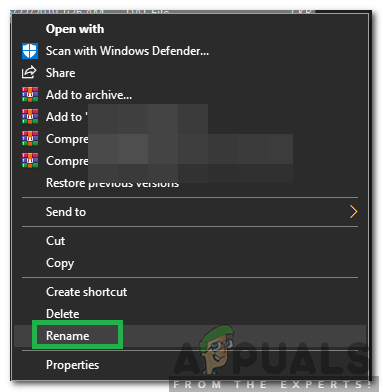
After you rename the file to a shorter name, retry the operation again and see if the issue has been resolved.
If you’re still seeing the same 0x80070141 error, move down to the next method below.
Method 6: Connecting as Media Device (MTP)
If you’re encountering the 0x80070141 error while trying to copy files to Windows from an Android device, chances are you’re seeing the error because the transfer protocol is “Connected as Camera”.
Several different users that were also encountering this issue have reported that they managed to resolve the issue after changing the transfer protocol to ‘Connected as a Media Device‘. After doing so and retrying the operation, they were able to copy the files without issues.
To change the transfer protocol to ‘Connected as a Media Device (MTP)’, simply swipe downloads from the top of the screen and you should see the details about your current USB connection. When you see that menu, simply select Media Device (MTP) and you should be good to go.
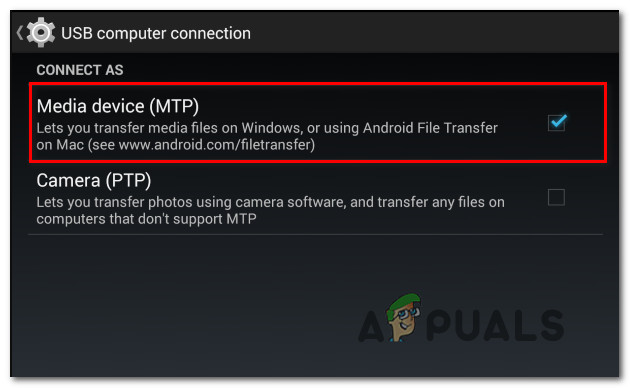
Method 7: Changing Transfer Setting
In some cases, some settings need to be reconfigured on your iPhone/iOS device which can sometimes get rid of this issue. Therefore, follow the guide below to reconfigure your transfer settings.
- Unlock your iOS device and navigate to settings.
- Go into “Photos” and scroll down until you see the “Transfer to Mac or PC” option.
- Click on it and select the “Keep Originals” option instead of the automatic one.
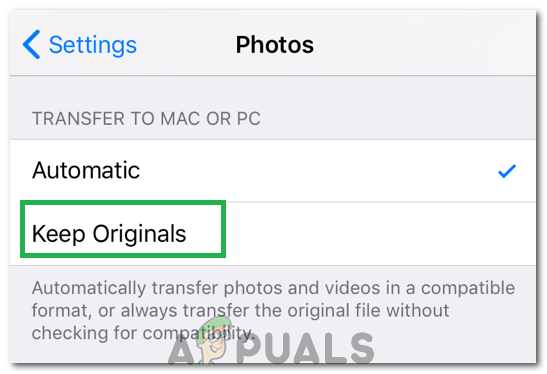
Clicking on the “Keep Originals” option - Check to see if the issue persists.




